We arrived in Porto late in the afternoon, only to find the full length of street where we were staying, Rua do Sol, under a tumultuous state of construction. Heavy equipment had deeply excavated the street and workers were laying new water lines. Temporarily parking at the end of street, in front of a small chapel – Capela dos Alfaiates – we dragged our suitcases down a sidewalk so narrow that we had to step into the doorframes of buildings to let oncoming folks pass. Having read too many mystery novels, I found myself thinking it would be the perfect spot to set a crime scene as we walked along the deep trench to our apartment. Maybe the fictional Inspector Ze Coelho would be called in after two American tourists see fingertips protruding from the dirt early one morning as they set out to explore Porto. That imaginary detour aside, we had a great time during our stay in Porto. There’s just so much to do and see here, where do you start? Our location was ideal, just around the corner from three pastelarias, bakeries, that were only doors apart and across the way from Batalha, the funicular station that could take us down the steep slope to the Douro River waterfront by the Ponte Luís I bridge. Tram 22 also starts from this plaza and follows a route past the Azulejo tile fronted Church of Saint Ildefonso, São Bento Station, to Igreja do Carmo where you can transfer to the Tram 18 line. A third route with Tram 1 Unfortunately, the trams are not as inexpensive Lisbon’s. We thought the two-day pass available, for ten euros, was too restrictive as it could only be used on back-to-back days and only on the historic trams. A single tram ride costs three euros. Many times, the trams are seriously delayed by congestion or improperly parked automobiles.follows the riverside to Foz at the mouth of the Douro River.
There’s just so much to do and see here, where do you start? Our location was ideal, just around the corner from three pastelarias, bakeries, that were only doors apart and across the way from Batalha, the funicular station that could take us down the steep slope to the Douro River waterfront by the Ponte Luís I bridge. Tram 22 also starts from this plaza and follows a route past the Azulejo tile fronted Church of Saint Ildefonso, São Bento Station, to Igreja do Carmo where you can transfer to the Tram 18 line. A third route with Tram 1 Unfortunately, the trams are not as inexpensive Lisbon’s. We thought the two-day pass available, for ten euros, was too restrictive as it could only be used on back-to-back days and only on the historic trams. A single tram ride costs three euros. Many times, the trams are seriously delayed by congestion or improperly parked automobiles.follows the riverside to Foz at the mouth of the Douro River. Unfortunately, the trams are not as inexpensive Lisbon’s. We thought the two-day pass available, for ten euros, was too restrictive as it could only be used on back-to-back days and only on the historic trams. A single tram ride costs three euros. Many times, the trams are seriously delayed by congestion or improperly parked automobiles.
Unfortunately, the trams are not as inexpensive Lisbon’s. We thought the two-day pass available, for ten euros, was too restrictive as it could only be used on back-to-back days and only on the historic trams. A single tram ride costs three euros. Many times, the trams are seriously delayed by congestion or improperly parked automobiles.  But the city really needs to be explored on foot to truly savor its charm and intrigue. Porto escaped the massive 1755 earthquake and tsunami that devasted Lisbon. Consequently, the city’s historic architectural gems, many dating as far back as the thirteenth century, still stand unscathed, and its ancient cobbled lanes still meander every which way, untouched by urban planning. With this in mind we decided to weave our way over to the Ponte Luís I bridge and eventually make our way down to the picturesque south bank of the Douro River as our destination for the day, stopping to explore what interested us along the way.
But the city really needs to be explored on foot to truly savor its charm and intrigue. Porto escaped the massive 1755 earthquake and tsunami that devasted Lisbon. Consequently, the city’s historic architectural gems, many dating as far back as the thirteenth century, still stand unscathed, and its ancient cobbled lanes still meander every which way, untouched by urban planning. With this in mind we decided to weave our way over to the Ponte Luís I bridge and eventually make our way down to the picturesque south bank of the Douro River as our destination for the day, stopping to explore what interested us along the way. Set at the far end of the plaza Largo Primeiro de Dezembro, next to a police station housed in an old monastery building, Igreja de Santa Clara is easy to miss. From a distance all you see is a nondescript archway framing an ancient door on the other side of a small courtyard. With one step over the high threshold we were transported back in time to another era. Sun light cascaded through high windows illuminating a cavernous sanctuary.
Set at the far end of the plaza Largo Primeiro de Dezembro, next to a police station housed in an old monastery building, Igreja de Santa Clara is easy to miss. From a distance all you see is a nondescript archway framing an ancient door on the other side of a small courtyard. With one step over the high threshold we were transported back in time to another era. Sun light cascaded through high windows illuminating a cavernous sanctuary. Almost every surface was covered with highly carved wood sculptures, gilded with gold-leaf or polychromed. The cathedral sparkled! The church dates to the 1400s, while the gilded Baroque interior was an 18th century renovation. Volunteers offered tours in return for donations to support restoration efforts. The wow factor was amazing.
Almost every surface was covered with highly carved wood sculptures, gilded with gold-leaf or polychromed. The cathedral sparkled! The church dates to the 1400s, while the gilded Baroque interior was an 18th century renovation. Volunteers offered tours in return for donations to support restoration efforts. The wow factor was amazing. We soon learned that the wealth of Porto rivaled that of Lisbon and the cathedrals spread across the city were the showcases of it. This might be the locale where you can experience a cathedral overdose, but you would be amiss to bypass such beauty. Maybe one cathedral a day, more like two, to keep lightning and thunder away?
We soon learned that the wealth of Porto rivaled that of Lisbon and the cathedrals spread across the city were the showcases of it. This might be the locale where you can experience a cathedral overdose, but you would be amiss to bypass such beauty. Maybe one cathedral a day, more like two, to keep lightning and thunder away? The armour-clad equestrian statue of Vímara Peres guards the approach to the Ponte Luis I bridge across the River Douro and some contemporary street art, that we’re not sure he would appreciate.
The armour-clad equestrian statue of Vímara Peres guards the approach to the Ponte Luis I bridge across the River Douro and some contemporary street art, that we’re not sure he would appreciate.
In the ninth century he led the armies that liberated northern Portugal, and it was the beginning of the end for the Moorish control of the country. This part of Porto was once encircled by fortress walls that extended all the way down to the river. From the bridge, we had a clear view of two watch towers and a small section of ramparts, which are all that remain of Muralha Fernandina, a medieval castle built by King D. Afonso IV in the early 1300s.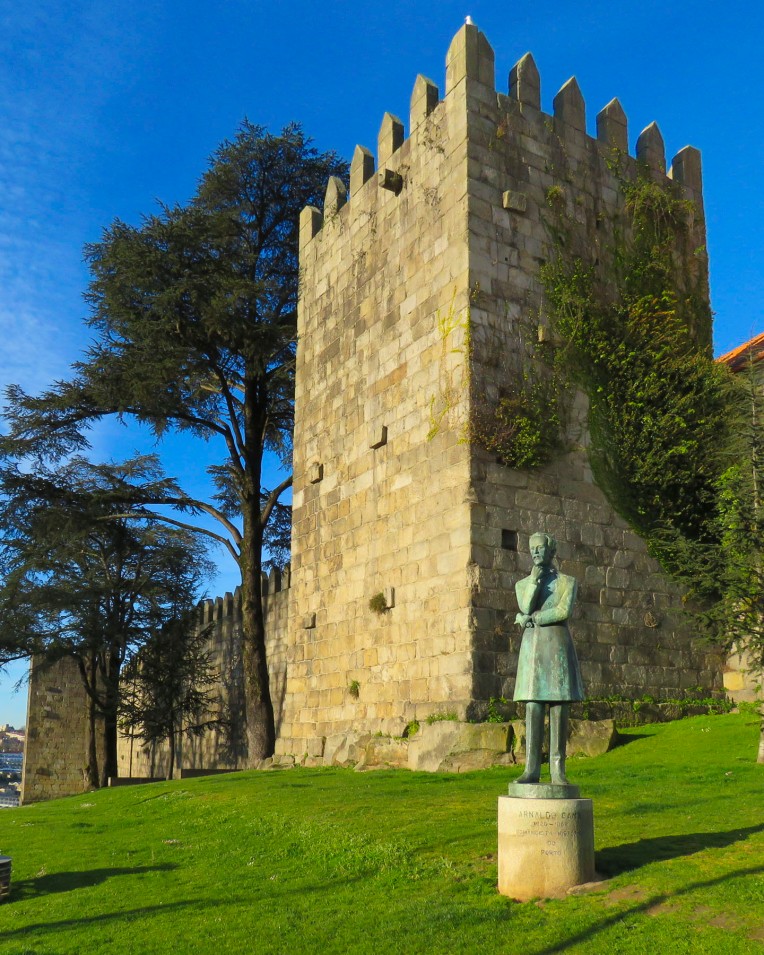 For nine-hundred years pontoon bridges and small boats were the major ways to cross the breath of the Douro River before the advent of iron construction. Designed by Théophile Seyrig, a former colleague of Eiffel, Ponte Luiz I opened in 1886 connecting both the upper and lower levels of the Ribeira area of Porto with Gaia. Today the graceful arch, with modern trams and pedestrians sharing its upper deck, is an iconic symbol for the integration of Porto’s history with the future.
For nine-hundred years pontoon bridges and small boats were the major ways to cross the breath of the Douro River before the advent of iron construction. Designed by Théophile Seyrig, a former colleague of Eiffel, Ponte Luiz I opened in 1886 connecting both the upper and lower levels of the Ribeira area of Porto with Gaia. Today the graceful arch, with modern trams and pedestrians sharing its upper deck, is an iconic symbol for the integration of Porto’s history with the future.  Across the bridge we worked our way up to Mosteiro da Serra do Pilar for the views. This spot and Jardim do Morro, the park at its base, are popular places to watch the sunset from.
Across the bridge we worked our way up to Mosteiro da Serra do Pilar for the views. This spot and Jardim do Morro, the park at its base, are popular places to watch the sunset from. We opted not to take the aerial tram down to the Gaia riverfront and continued our walk, looking for the right restaurant set amidst the fifty port cellars that line the waterfront. Perched atop the port cellar Espaço Porto Cruz, the Terrace Lounge 360º fit the bill.
We opted not to take the aerial tram down to the Gaia riverfront and continued our walk, looking for the right restaurant set amidst the fifty port cellars that line the waterfront. Perched atop the port cellar Espaço Porto Cruz, the Terrace Lounge 360º fit the bill. The day was beautiful, lunch was delightfully slow paced and of course we enjoyed some wine. We’ve found the restaurants in Portugal never rush you to leave. The table is yours for however long you wish to stay. We soaked in the warm sun, breathed in the crisp Spring air and absorbed the good life surrounding us.
The day was beautiful, lunch was delightfully slow paced and of course we enjoyed some wine. We’ve found the restaurants in Portugal never rush you to leave. The table is yours for however long you wish to stay. We soaked in the warm sun, breathed in the crisp Spring air and absorbed the good life surrounding us.
On our leisurely stroll back along the waterfront, we admired the colorful rabelo boats anchored along the quay and Porto’s profile reflecting in the river to the lower deck of the Ponte Luiz I bridge. Here we crossed to take the Funicular dos Guindais, €2.50, back up the steep embankment to the Batalha district. The route of the funicular passes some of the oldest homes and alleys in Porto which we continued to explore for a while before heading back to our lodging for the evening.
Till next time, Craig & Donna.









 Coimbra is a city for walkers. Ancient lanes crisscross the historic district, weaving their way steeply up the hillside until you eventually reach the University of Coimbra, which crowns this charming city. But the journey there is so rewarding, with arched alleys, cathedrals and numerous shops and restaurants all vying for exploration.
Coimbra is a city for walkers. Ancient lanes crisscross the historic district, weaving their way steeply up the hillside until you eventually reach the University of Coimbra, which crowns this charming city. But the journey there is so rewarding, with arched alleys, cathedrals and numerous shops and restaurants all vying for exploration.



 Deceptively, many of the marble columns and surrounds of the altar are actually wood, painted to imitate marble. The cathedral aged poorly in its early centuries as the result of repeated Spring flooding from the Mondego River. In the 1700s Azulejos tiles were added to the walls to cover severely water-damaged early fresco paintings. A spectacular and huge four thousand pipe organ hangs precariously from the wall of the sanctuary. Apparently, it’s so difficult to play only three people know how. The monastery is huge with many interesting rooms and intriguing details to explore.
Deceptively, many of the marble columns and surrounds of the altar are actually wood, painted to imitate marble. The cathedral aged poorly in its early centuries as the result of repeated Spring flooding from the Mondego River. In the 1700s Azulejos tiles were added to the walls to cover severely water-damaged early fresco paintings. A spectacular and huge four thousand pipe organ hangs precariously from the wall of the sanctuary. Apparently, it’s so difficult to play only three people know how. The monastery is huge with many interesting rooms and intriguing details to explore.




























 Azulejo tile murals edged with religious statues framed the sculpted fountain. At the top of the fountain water gurgled from under a statue of the Virgin Mary, symbolically giving life to the waterfall. Symmetrical stairways on either side led deeper into the heavily shaded park.
Azulejo tile murals edged with religious statues framed the sculpted fountain. At the top of the fountain water gurgled from under a statue of the Virgin Mary, symbolically giving life to the waterfall. Symmetrical stairways on either side led deeper into the heavily shaded park.









 We crisscrossed these serpentine estuaries multiple times during the day as we drove through verdant pine forests along roads that hugged the curves of the land. Isolated, whitewashed villages dotted the mountainside.
We crisscrossed these serpentine estuaries multiple times during the day as we drove through verdant pine forests along roads that hugged the curves of the land. Isolated, whitewashed villages dotted the mountainside.




















![IMG_8406[41116] IMG_8406[41116]](https://2suitcasesfor2years.files.wordpress.com/2019/07/img_840641116.jpg?w=210&resize=210%2C157&h=157#038;h=157)


![IMG_8535[41117] IMG_8535[41117]](https://2suitcasesfor2years.files.wordpress.com/2019/07/img_853541117.jpg?w=210&resize=210%2C157&h=157#038;h=157)
![IMG_4442[41105]-2 IMG_4442[41105]-2](https://2suitcasesfor2years.files.wordpress.com/2019/07/img_444241105-2.jpg?w=484&resize=484%2C363&h=363#038;h=363)
![IMG_4328[41104]-2 IMG_4328[41104]-2](https://2suitcasesfor2years.files.wordpress.com/2019/07/img_432841104-2.jpg?w=272&resize=272%2C363&h=363#038;h=363)
 When we retired early, a year ago, we had to choose health insurance or travel. We made the decision to go without U.S. health insurance, because it’s too damn unaffordable and wouldn’t cover us outside the U.S. anyway. We chose travel insurance instead, with medical evacuation, and we pay out of pocket for wellness care and dentistry. Our two years on the road will bridge us until age 65 when we qualify for Medicare. And it’s surprising how affordable excellent healthcare is in other countries. We’ve paid $25.00 for an emergency room visit to a private hospital and $5.00 for the prescriptions in Ecuador to treat high altitude sickness. Our travel insurance paid fully for a visit to an ENT specialist in Lisbon to treat a persistent sinus infection. I’ve visited dentists in Cuenca, Ecuador for a tooth extraction and bridge; Sofia, Bulgaria for a broken filling; and Cape Town, South Africa for a root canal. The care has been excellent and extremely inexpensive compared to pricing in the United States. Though when we are in the United States travel insurance only covers us if we are one hundred miles away from our previous home in Pennsylvania.
When we retired early, a year ago, we had to choose health insurance or travel. We made the decision to go without U.S. health insurance, because it’s too damn unaffordable and wouldn’t cover us outside the U.S. anyway. We chose travel insurance instead, with medical evacuation, and we pay out of pocket for wellness care and dentistry. Our two years on the road will bridge us until age 65 when we qualify for Medicare. And it’s surprising how affordable excellent healthcare is in other countries. We’ve paid $25.00 for an emergency room visit to a private hospital and $5.00 for the prescriptions in Ecuador to treat high altitude sickness. Our travel insurance paid fully for a visit to an ENT specialist in Lisbon to treat a persistent sinus infection. I’ve visited dentists in Cuenca, Ecuador for a tooth extraction and bridge; Sofia, Bulgaria for a broken filling; and Cape Town, South Africa for a root canal. The care has been excellent and extremely inexpensive compared to pricing in the United States. Though when we are in the United States travel insurance only covers us if we are one hundred miles away from our previous home in Pennsylvania. We plan on purchasing a home when we return to the United States. Right now, though, our budget is plus/minus $1000.00 per month for an apartment. One thousand per month for housing goes much further overseas than in the states and allows us to live in unique and interesting locales.
We plan on purchasing a home when we return to the United States. Right now, though, our budget is plus/minus $1000.00 per month for an apartment. One thousand per month for housing goes much further overseas than in the states and allows us to live in unique and interesting locales.![IMG_3666[31053] IMG_3666[31053]](https://2suitcasesfor2years.files.wordpress.com/2019/07/img_366631053.jpg?w=226&resize=226%2C301&h=301#038;h=301)
![C9307CA4-72DA-4D6B-8838-8D3B4A103C88[35084] C9307CA4-72DA-4D6B-8838-8D3B4A103C88[35084]](https://2suitcasesfor2years.files.wordpress.com/2019/07/c9307ca4-72da-4d6b-8838-8d3b4a103c8835084.jpg?w=301&resize=301%2C301&h=301#038;h=301&crop=1)
![IMG_3677[31056] IMG_3677[31056]](https://2suitcasesfor2years.files.wordpress.com/2019/07/img_367731056.jpg?w=225&resize=225%2C301&h=301#038;h=301)
![IMG_3463[31065] IMG_3463[31065]](https://2suitcasesfor2years.files.wordpress.com/2019/07/img_346331065.jpg?w=378&resize=378%2C284&h=284#038;h=284)
![IMG_3140[31166] IMG_3140[31166]](https://2suitcasesfor2years.files.wordpress.com/2019/07/img_314031166.jpg?w=378&resize=378%2C284&h=284#038;h=284)
![IMG_3737[35074]](https://2suitcasesfor2years.files.wordpress.com/2019/07/img_373735074.jpg?w=764)
 We’ve rented cars in Ecuador, Guatemala, Portugal, Bulgaria and South Africa. Near the Schist villages in the mountains of central Portugal we gave a lift to two hikers, who were exhausted from a long trek without water. We ended up having a delightful afternoon and lunch with them. Aside from the deeply rutted dirt roads of the Andes Mountain range in Ecuador, South Africa with its driving on the left has proven to be the most difficult. We find that a pilot plus navigator system works well, with the latter reminding the pilot to stay left and make very wide right-hand turns. Interesting traffic signs dot the roads here: Caution Tortoise and Baboons Share this Road Too, Watch for Stray Cattle. I chuckled to myself when I passed a sign that I thought said Zebras Humping, only to realize a moment later it was a speed bump when I hit it at a pretty good clip. Caution High Winds – Parents Hold Your Children Firmly by the Hand as there is Mortal Danger of Them Blowing Off, greeted us in the parking lot of a scenic and windy overlook. South Africa has a well deployed and concealed electronic camera system and we’ve received our first notice of a traffic violation from the rental car company.
We’ve rented cars in Ecuador, Guatemala, Portugal, Bulgaria and South Africa. Near the Schist villages in the mountains of central Portugal we gave a lift to two hikers, who were exhausted from a long trek without water. We ended up having a delightful afternoon and lunch with them. Aside from the deeply rutted dirt roads of the Andes Mountain range in Ecuador, South Africa with its driving on the left has proven to be the most difficult. We find that a pilot plus navigator system works well, with the latter reminding the pilot to stay left and make very wide right-hand turns. Interesting traffic signs dot the roads here: Caution Tortoise and Baboons Share this Road Too, Watch for Stray Cattle. I chuckled to myself when I passed a sign that I thought said Zebras Humping, only to realize a moment later it was a speed bump when I hit it at a pretty good clip. Caution High Winds – Parents Hold Your Children Firmly by the Hand as there is Mortal Danger of Them Blowing Off, greeted us in the parking lot of a scenic and windy overlook. South Africa has a well deployed and concealed electronic camera system and we’ve received our first notice of a traffic violation from the rental car company. 




![IMG_6810[39428]-2 IMG_6810[39428]-2](https://2suitcasesfor2years.files.wordpress.com/2019/07/img_681039428-2.jpg?w=492&resize=492%2C369&h=369#038;h=369)
![IMG_4520[41112]-2 IMG_4520[41112]-2](https://2suitcasesfor2years.files.wordpress.com/2019/07/img_452041112-2.jpg?w=264&resize=264%2C369&h=369#038;h=369)



 Monsanto
Monsanto


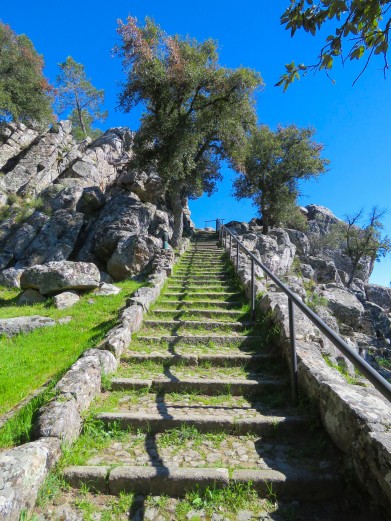

 Monsanto
Monsanto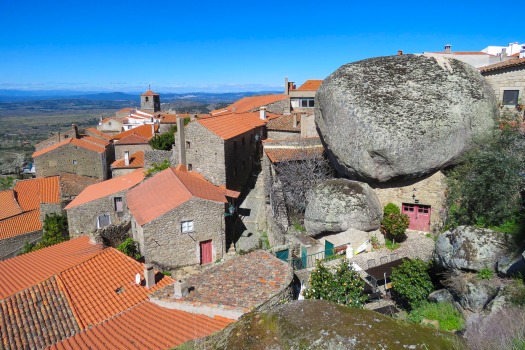

















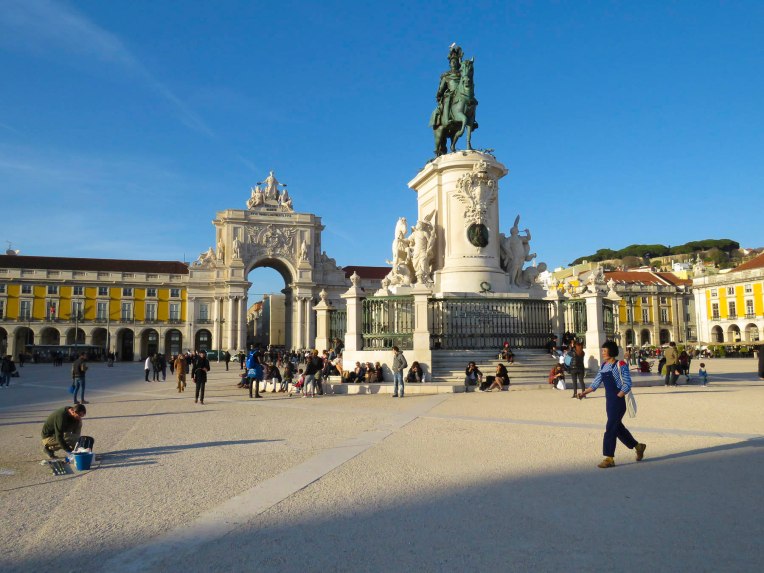





 Walking along the river towards Cais do Sodré by the Ministério da Defesa Nacional – Marinha building you can see remnants of a stone wharf in the reflecting pool; landlocked now, it’s all that remains of an extensive old navy quay. There are many places to dine in this area, but we preferred to continue onto Av. 24 de Julho to check out the street art in the area and then stop at The Time Out Market.
Walking along the river towards Cais do Sodré by the Ministério da Defesa Nacional – Marinha building you can see remnants of a stone wharf in the reflecting pool; landlocked now, it’s all that remains of an extensive old navy quay. There are many places to dine in this area, but we preferred to continue onto Av. 24 de Julho to check out the street art in the area and then stop at The Time Out Market.




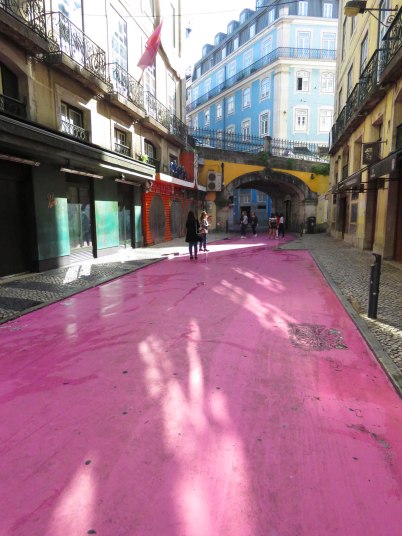

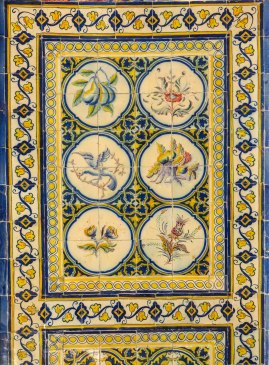

 One of the nicest Sundays we enjoyed was spent at the
One of the nicest Sundays we enjoyed was spent at the 




![IMG_3140[31166] IMG_3140[31166]](https://2suitcasesfor2years.files.wordpress.com/2019/06/img_314031166.jpg?w=484&resize=484%2C363&h=363#038;h=363)


![IMG_3170[31169] IMG_3170[31169]](https://2suitcasesfor2years.files.wordpress.com/2019/06/img_317031169.jpg?w=272&resize=272%2C363&h=363#038;h=363)


























 As if guarding the plaza,
As if guarding the plaza, 

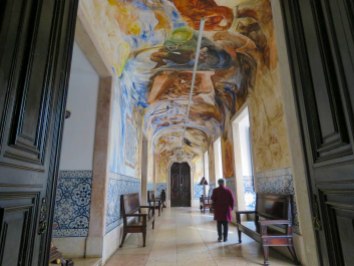





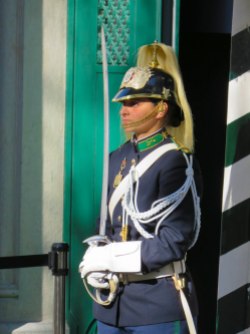




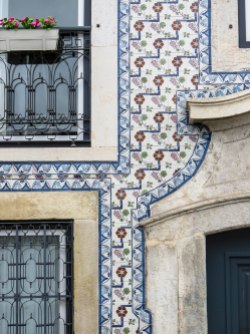
 Shady Miradouro de São Pedro de Alcântara overlooks this colorful chaos and has splendid views of Lisbon below. From the miradouro it’s a gentle uphill walk into Bairro Alto. Fortunately, there’s no lack of places to rejuvenate yourself along the way. For lunch we found
Shady Miradouro de São Pedro de Alcântara overlooks this colorful chaos and has splendid views of Lisbon below. From the miradouro it’s a gentle uphill walk into Bairro Alto. Fortunately, there’s no lack of places to rejuvenate yourself along the way. For lunch we found 






 Set in a historic 1890s building in Cais do Sodré, this is a huge, lively food court with numerous restaurant choices that is very popular with Lisboans. Whatever you are craving at the time, you’ll find something satisfying here. Next door, during the week, Mercado da Ribeira operates a central market with fish, meat and produce vendors offering Portugal’s finest products. Brightly painted Pink Street, popular for its club scene, is nearby.
Set in a historic 1890s building in Cais do Sodré, this is a huge, lively food court with numerous restaurant choices that is very popular with Lisboans. Whatever you are craving at the time, you’ll find something satisfying here. Next door, during the week, Mercado da Ribeira operates a central market with fish, meat and produce vendors offering Portugal’s finest products. Brightly painted Pink Street, popular for its club scene, is nearby.









 Heading west, tram 28 weaves through a very narrow section similar to parts of its route in Alfama, before reaching the open area around Assembleia da República. The parliament of Portugal is headquartered in a neoclassical building that was first used as a convent in the sixteenth century. Formal gardens behind the parliament building, hidden by an imposing wall, can be seen from tram 28 or if you stand on your tip-toes and peer over. Never immune from criticism, the politicians must endure a large satirical wall mural, painted on a nearby building, as they head to work each day.
Heading west, tram 28 weaves through a very narrow section similar to parts of its route in Alfama, before reaching the open area around Assembleia da República. The parliament of Portugal is headquartered in a neoclassical building that was first used as a convent in the sixteenth century. Formal gardens behind the parliament building, hidden by an imposing wall, can be seen from tram 28 or if you stand on your tip-toes and peer over. Never immune from criticism, the politicians must endure a large satirical wall mural, painted on a nearby building, as they head to work each day.





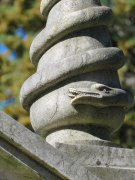












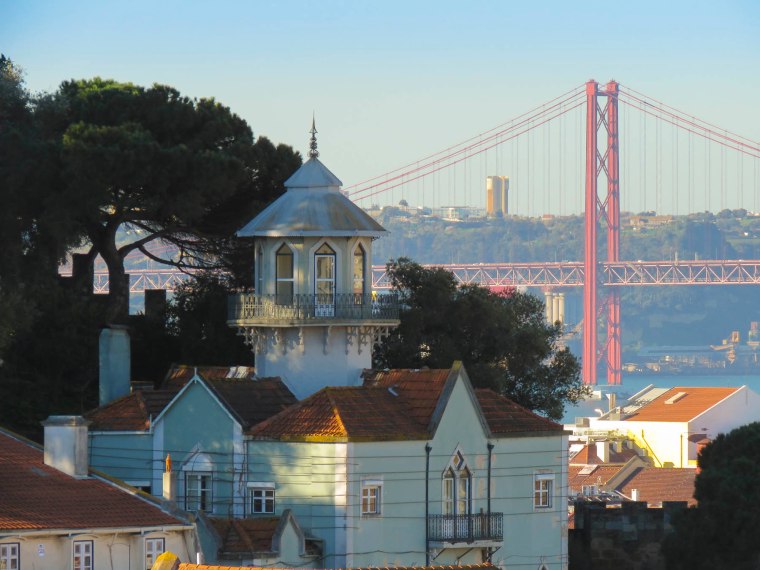







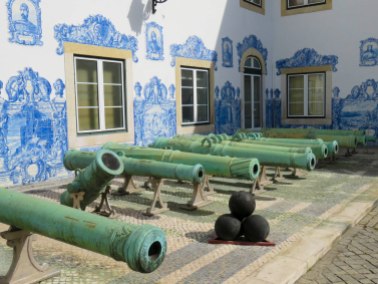






















![IMG_3433[31180] IMG_3433[31180]](https://2suitcasesfor2years.files.wordpress.com/2019/04/img_343331180.jpg?w=251&resize=251%2C334&h=334#038;h=334)




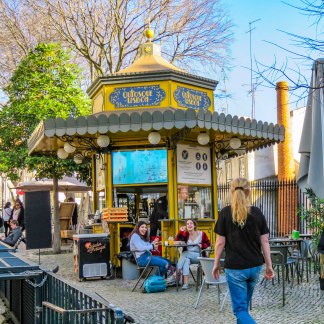
![IMG_3463[31065] IMG_3463[31065]](https://2suitcasesfor2years.files.wordpress.com/2019/04/img_346331065.jpg?w=432&resize=432%2C324&h=324#038;h=324)









 Archeological excavations next to the Castelo de Sao Jorge have revealed evidence of a Phoenician settlement that dated to 1200 BC, a Roman amphitheater, and walls built by the Visigoths before the Moors arrived. Today the rumbling sound of wheeled suitcases on the cobble stone alleys echoes, almost continuously, off these walls weathered by time. Tourists make their way to newly renovated Airbnb’s, as we did, much to the concern of older residents of Alfama who worry about being gentrified out of their homes.
Archeological excavations next to the Castelo de Sao Jorge have revealed evidence of a Phoenician settlement that dated to 1200 BC, a Roman amphitheater, and walls built by the Visigoths before the Moors arrived. Today the rumbling sound of wheeled suitcases on the cobble stone alleys echoes, almost continuously, off these walls weathered by time. Tourists make their way to newly renovated Airbnb’s, as we did, much to the concern of older residents of Alfama who worry about being gentrified out of their homes.




 Like our neighbors, we hung our laundry from our windows to dry. Most evenings the melancholic melodies of traditional Fado music drifted softly down Alfama’s alleys from several restaurants nearby.
Like our neighbors, we hung our laundry from our windows to dry. Most evenings the melancholic melodies of traditional Fado music drifted softly down Alfama’s alleys from several restaurants nearby.
![IMG_3463[31065]](https://2suitcasesfor2years.files.wordpress.com/2019/04/img_346331065.jpg?w=764)


![IMG_3666[31053] IMG_3666[31053]](https://2suitcasesfor2years.files.wordpress.com/2019/04/img_366631053.jpg?w=156&resize=156%2C209&h=209#038;h=209)
![IMG_3282[31171] IMG_3282[31171]](https://2suitcasesfor2years.files.wordpress.com/2019/04/img_328231171.jpg?w=278&resize=278%2C209&h=209#038;h=209)
![IMG_3140[31166] IMG_3140[31166]](https://2suitcasesfor2years.files.wordpress.com/2019/04/img_314031166.jpg?w=484&resize=484%2C363&h=363#038;h=363)
![IMG_3286[31172] IMG_3286[31172]](https://2suitcasesfor2years.files.wordpress.com/2019/04/img_328631172.jpg?w=272&resize=272%2C363&h=363#038;h=363)











